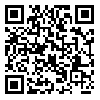Volume 12, Issue 3 (Aug & Sep 2018)
payavard 2018, 12(3): 201-209 |
Back to browse issues page
Download citation:
BibTeX | RIS | EndNote | Medlars | ProCite | Reference Manager | RefWorks
Send citation to:



BibTeX | RIS | EndNote | Medlars | ProCite | Reference Manager | RefWorks
Send citation to:
Changizi V, Sadeghi H, Alizadeh M, Aghaei A, Yazdanmehr M. Evaluation of the Basic Dosimetric Properties of Calcium Sulfide Crystals with Rare Earth Elements as a Sensor of OSL Dosimeter. payavard 2018; 12 (3) :201-209
URL: http://payavard.tums.ac.ir/article-1-6572-en.html
URL: http://payavard.tums.ac.ir/article-1-6572-en.html
1- Professor, Radiation Sciences Department, School of Allied Medical Sciences, Tehran University of Medical Sciences, Tehran, Iran
2- Assistant Professor, Physics Department, School of Physics Sciences, Malek Ashtar University of Technology, Isfahan, Iran
3- Master of Science in Radiobiology & Radiation Protection, Radiation Sciences Depertment, School of Allied Medical Sciences, Tehran University of Medical Sciences, Tehran, Iran ,radiobiology1991@gmail.com
4- Instructor, Physics Department, School of Physics Sciences, Malek Ashtar University of Technology, Isfahan, Iran
2- Assistant Professor, Physics Department, School of Physics Sciences, Malek Ashtar University of Technology, Isfahan, Iran
3- Master of Science in Radiobiology & Radiation Protection, Radiation Sciences Depertment, School of Allied Medical Sciences, Tehran University of Medical Sciences, Tehran, Iran ,
4- Instructor, Physics Department, School of Physics Sciences, Malek Ashtar University of Technology, Isfahan, Iran
Abstract: (4176 Views)
Background and Aim: Today, OSL (Optically Stimulated Luminescence) dosimetry system based on optical stimulation, includes systems that can meet many requirements for radiation protection in the field of medicine and space. The Calcium Sulfide (CaS) is one of the earth's alkaline sulfide materials which can be used as a detector in this system. In this research, some of the dosimetry properties of CaS doped with Cerium, (Ce), and Samarium, (Sm) elements were investigated as OSL dosimeter sensor.
Materials and Methods: First, attenuation of x-rays through the sensors were analyzed and the absorbed dose rate was evaluated using MCNP code. After calcium sulfide tablets were fabricated and their concentration optimized, the maximum waiting time prior to readout was obtained. In addition, the repeatability and linear response of the detector were determined as a function of CaS concentration.
Results: Eight minutes after radiation exposure of detectors, the detection output signals became stable. This stability was monitored for at least 30 minutes after irradiation. The repeatability in measurements was observed within the dose ranges of 100 to 860 mGy. The dosimeter response was observed linear over this dose ranges.
Conclusion: According to the above-observed results and statistical evaluations, one can conclude that the CaS:Ce,Sm crystal is a proper sensor for OSL dosimeter systems in medicine and space studies.
Materials and Methods: First, attenuation of x-rays through the sensors were analyzed and the absorbed dose rate was evaluated using MCNP code. After calcium sulfide tablets were fabricated and their concentration optimized, the maximum waiting time prior to readout was obtained. In addition, the repeatability and linear response of the detector were determined as a function of CaS concentration.
Results: Eight minutes after radiation exposure of detectors, the detection output signals became stable. This stability was monitored for at least 30 minutes after irradiation. The repeatability in measurements was observed within the dose ranges of 100 to 860 mGy. The dosimeter response was observed linear over this dose ranges.
Conclusion: According to the above-observed results and statistical evaluations, one can conclude that the CaS:Ce,Sm crystal is a proper sensor for OSL dosimeter systems in medicine and space studies.
Send email to the article author
| Rights and permissions | |
 |
This work is licensed under a Creative Commons Attribution-NonCommercial 4.0 International License. |





